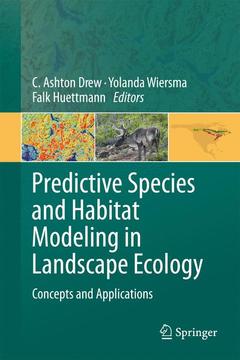Predictive Species and Habitat Modeling in Landscape Ecology, 2011 Concepts and Applications
Coordonnateurs : Drew C. Ashton, Wiersma Yolanda F., Huettmann Falk

Most projects in Landscape Ecology, at some point, define a species-habitat association. These models are inherently spatial, dealing with landscapes and their configurations. Whether coding behavioral rules for dispersal of simulated organisms through simulated landscapes, or designing the sampling extent of field surveys and experiments in real landscapes, landscape ecologists must make assumptions about how organisms experience and utilize the landscape. These convenient working postulates allow modelers to project the model in time and space, yet rarely are they explicitly considered. The early years of landscape ecology necessarily focused on the evolution of effective data sources, metrics, and statistical approaches that could truly capture the spatial and temporal patterns and processes of interest. Now that these tools are well established, we reflect on the ecological theories that underpin the assumptions commonly made during species distribution modeling and mapping. This is crucial for applying models to questions of global sustainability.
Due to the inherent use of GIS for much of this kind of research, and as several authors? research involves the production of multicolored map figures, there would be an 8-page color insert. Additional color figures could be made available through a digital archive, or by cost contributions of the chapter authors. Where applicable, would be relevant chapters? GIS data and model code available through a digital archive. The practice of data and code sharing is becoming standard in GIS studies, is an inherent method of this book, and will serve to add additional research value to the book for both academic and practitioner audiences.
Foreword (Jianguo Liu*)
Introduction (Ashton Drew*, Falk Huettmann*, Yolanda Wiersma*)
Current State of Knowledge
1. Statistical, ecological and data models (Nicolette Cagle, Mike Austin)
2. The state of spatio-temporal statistical modeling in ecology (Mevin Hooten*)
Integration of Ecological Theory into Modeling Practice
3. Linking ecological theory with species-habitat modeling (Alexandre Hirzel*)
4. The role of assumption in predictions of habitat availability and quality (Ed Laurent*)
5. Habitat quality and ecological theory: the importance of variation in space and time
(Robert Fletcher*)
6. Data management as the scientific foundation for modeling (Falk Huettmann* and
Benjamin Zuckerberg*)
Simplicity, Complexity, and Uncertainty in Applied Models
7. Variation, use, and mis-use of statistical models: effects on the interpretation of research
results (Yolanda Wiersma*)
8. Modeling landcover pattern and change using Random Forest (Jeffrey Evans)
9. Focused assessment of scale-dependent vegetation pattern (Todd Lookingbill)
10. Understanding year-to-year inconsistency in bird-landscape relations: the influence of
life-history traits and model selection uncertainty (Sam Riffel)
11. Boreal toad (Bufo boreas boreas) population connectivity in Yellowstone National Park:
quantifying matrix resistance and model uncertainty using landscape genetics (Melanie
Murphy*)
12. Assessment of how fine-scale expert opinion improves large-scale regional species
distribution models (Ashton Drew*)
Designing Models for Increased Utility
13. Integrating and improving GAP wildlife habitat models with IFMAP, Michigan's forest
management decision support environment (Jay Roberts*)
14. Linking modeling to adaptive management (Tom Nudds)
15. Linking spatially explicit predictions with models in strategic conservation planning,
forecasting and cumulative impact assessments (Joshua Lawler*, Falk Huettmann*,
Yolanda Wiersma*)
Conclusion and Outlook (Ashton Drew*, Falk Huettmann*, Yolanda Wiersma*)
Highlights how fundamental ecological theories are being explicitly integrated into the model building processes
offers practical examples of how modelers are addressing the conflict between the complexity of ecological systems and the relative simplicity of their modeled systems
Presents novel prediction methods to identify and quantify sources of uncertainty and variability in species habitat associations in time and space
Date de parution : 10-2014
Ouvrage de 313 p.
15.2x22.9 cm
Disponible chez l'éditeur (délai d'approvisionnement : 15 jours).
Prix indicatif 242,64 €
Ajouter au panierDate de parution : 11-2010
Ouvrage de 313 p.
15.2x22.9 cm
Disponible chez l'éditeur (délai d'approvisionnement : 15 jours).
Prix indicatif 242,64 €
Ajouter au panier


